What Are Amino Acids? Essential Nutrients for All Life
Amino acids are organic compounds that make up proteins and are the source of our very life. This article provides an overview of amino acids, their types, and their key roles in the body.
What Are Amino Acids?
Amino acids are organic compounds that make up proteins. They are essential to all living things, from microbes to humans.
Amino acids are derived from the proteins in the food we eat on a daily basis after being digested. When we consume food, proteins are broken down in the intestines to produce amino acids. When these amino acids are absorbed into the body, proteins necessary for skin, hair, muscles, etc. are produced.
Amino acids are the building blocks of proteins. There are over 100,000 types of protein, all made up of just 20 amino acids.
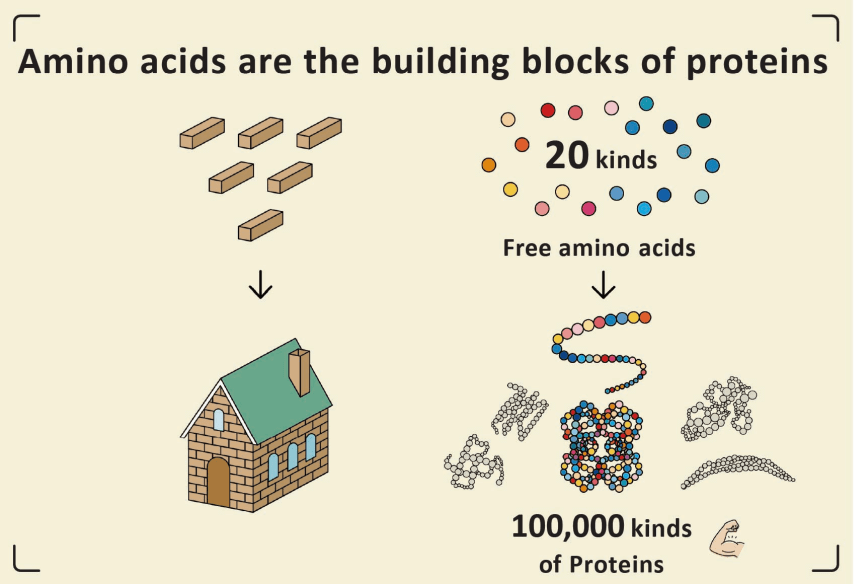
All living bodies, including humans, contain the same 20 amino acids.
The type, number, and sequence of amino acids in a protein are all precisely defined.
If even one amino acid is missing, proteins cannot be synthesized, and all body functions may be affected.
In other words, amino acids are the foundation of life itself.
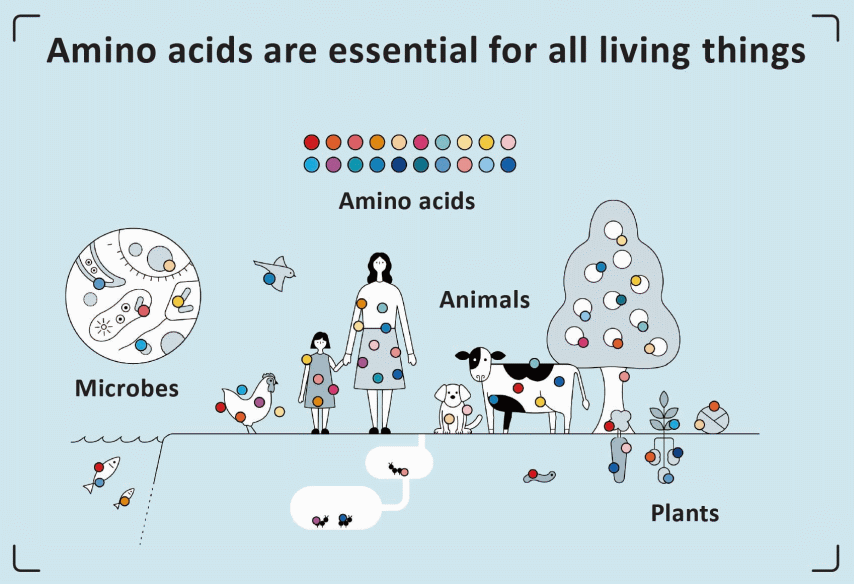
Amino acids make up 20% of the human body?
Amino acids make up about 20% of our bodies by weight, or about 50% of our solid body mass. They are the next largest component in our bodies after water. The body of a person weighing 50kg contains about 10kg of amino acids.
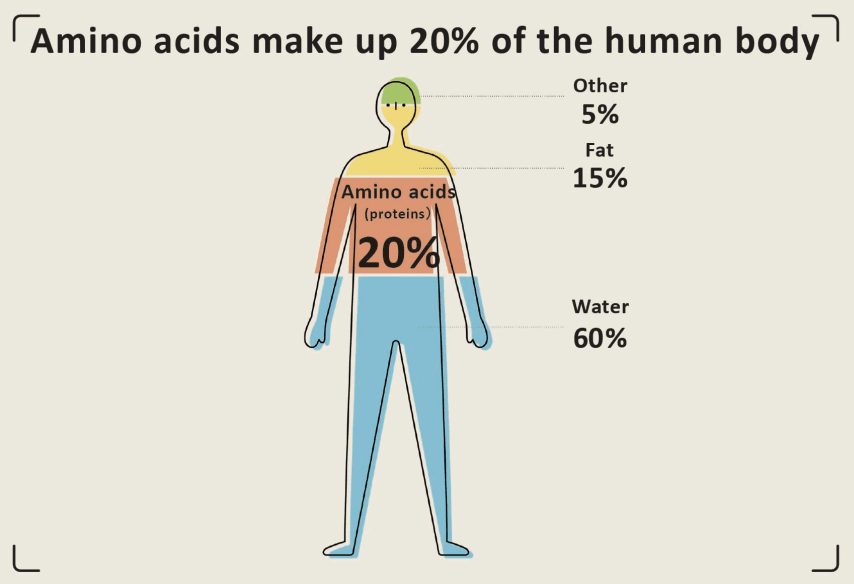
Amino acids are major components of muscles, organs, the digestive tract, skin, bones, and hair, as well as materials for hormones, enzymes, and antibodies that regulate body functions. Therefore, consuming the correct amount of protein is essential for maintaining good health because protein is the source of amino acids.
20 types of amino acids
Of the 20 amino acids, nine cannot be synthesized by the body and are called “essential amino acids.” The remaining eleven, which can be synthesized internally, are known as “non-essential amino acids.”
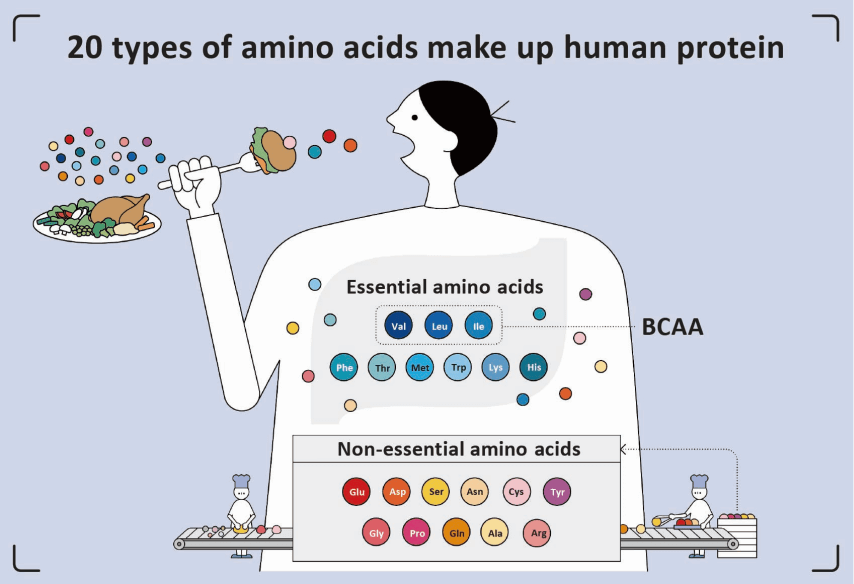
What are essential amino acids?
Nine of the twenty amino acids are considered essential because they cannot be synthesized in the body and must be obtained from food. These are the essential or indispensable amino acids.
Histidine
Isoleucine
Leucine
Lysine
Methionine
Phenylalanine
Threonine
Tryptophan
Valine
What are non-essential amino acids?
The remaining eleven amino acids can be synthesized from other amino acids in the body and are therefore referred to as non-essential or dispensable amino acids.
Alanine
Arginine
Asparagine
Aspartic acid
Cysteine
Glutamic acid
Glutamine
Glycine
Proline
Serine
Tyrosine
However, both essential and non-essential amino acids play an important role in sustaining life.
What are conditionally essential amino acids?
Some non-essential amino acids—such as arginine, cysteine, and tyrosine—are referred to as semi-essential or conditionally essential because their levels may become insufficient during infancy, illness, injury, or recovery from surgery.
Learn more about individual amino acids here:
What role do amino acids play in the human body?
There are three major roles that amino acids play in our human body.
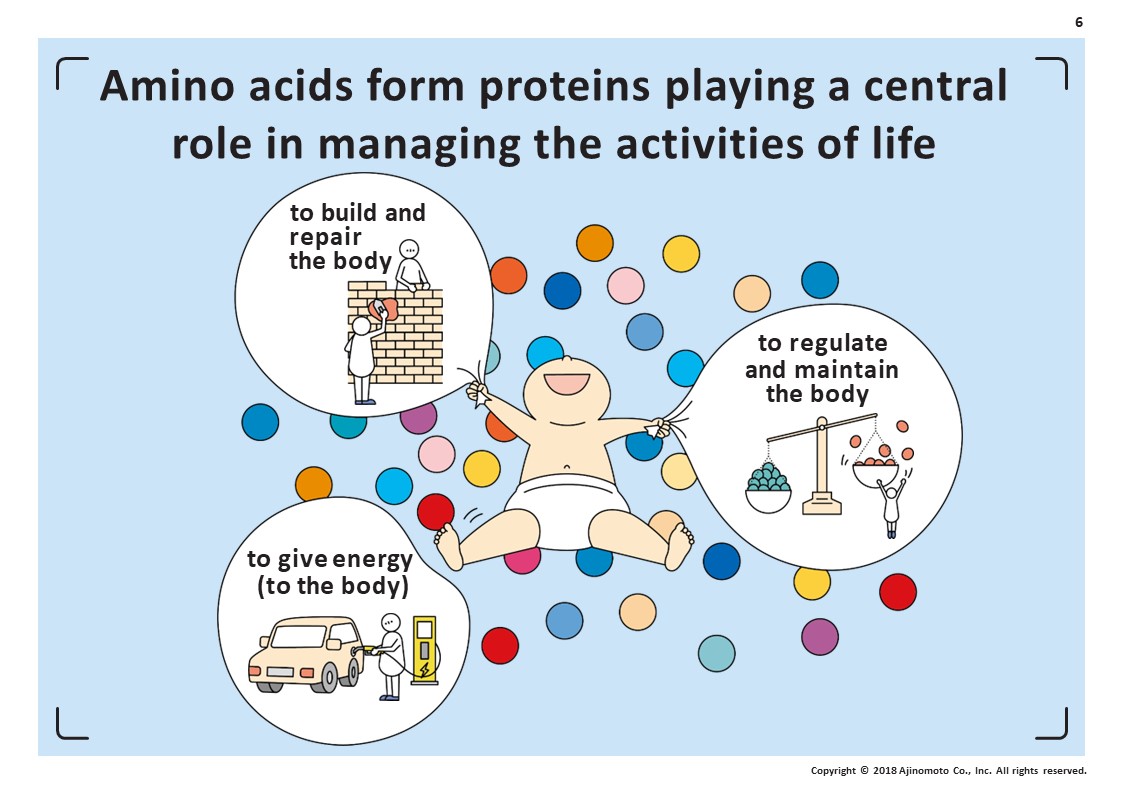
Building and repairing the body
Amino acids combine to form the proteins that not only make up our bodies but also regulate most of their essential functions. Collagen, keratin, and hemoglobin are just three examples of proteins in the human body.
Regulating and maintaining the body
Amino acids also regulate and maintain our bodily processes by forming enzymes or hormones such as thyroxine, insulin and adrenaline.
Giving energy to the body
Another important function of amino acids is to supply energy to the body. Typically, a healthy body on an average diet uses carbohydrates as a primary source of fuel. However, proteins and amino acids can be used as fuel as a last resort when the primary sources are depleted through rigorous exercise.
Amino acids add taste and color to meals
Amino acids also play a vital role in creating the flavors of food. Proteins themselves have little flavor, but each amino acid has a distinct taste. The combination and ratio of amino acids greatly influence the flavor of food. The best-known amino acid is glutamic acid, which is responsible for umami—savoriness or the “fifth taste”—and is also used in AJI-NO-MOTO® umami seasoning.
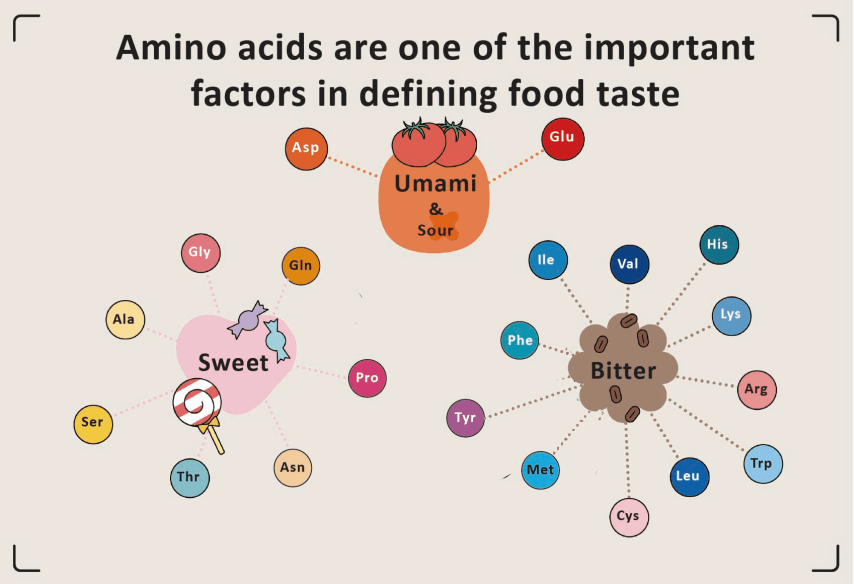
Since our bodies cannot synthesize the nine essential amino acids, we have to consume them in our food. A balanced diet that includes all essential amino acids is crucial for proper bodily function.
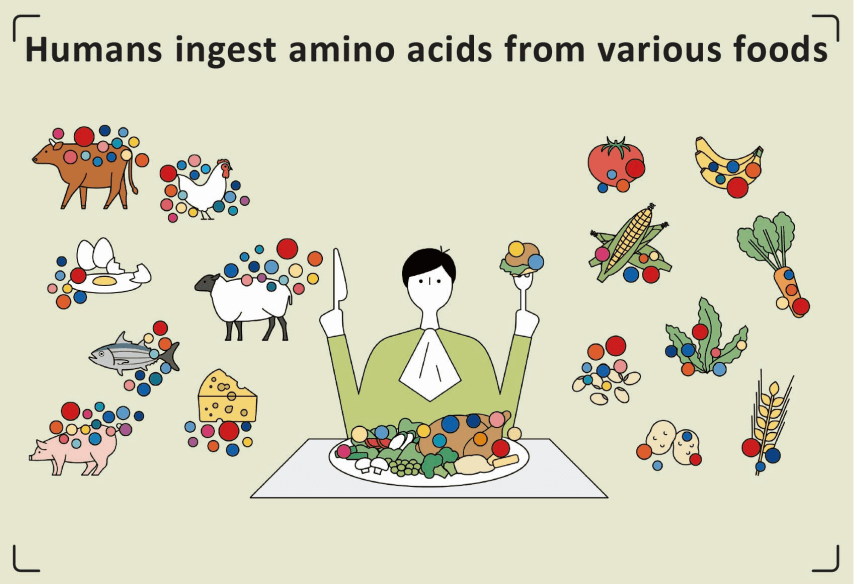
How do amino acids help with balanced nutrition?
Balanced nutrition is important for staying healthy. To stay healthy, the body needs a daily intake of the five major nutrients: proteins, fats, carbohydrates, vitamins, and minerals. Guidelines on the recommended daily intake of these nutrients are published by the World Health Organization (WHO) and other international bodies. Failure to maintain a good nutritional balance can raise the risk of obesity and other lifestyle-related diseases.
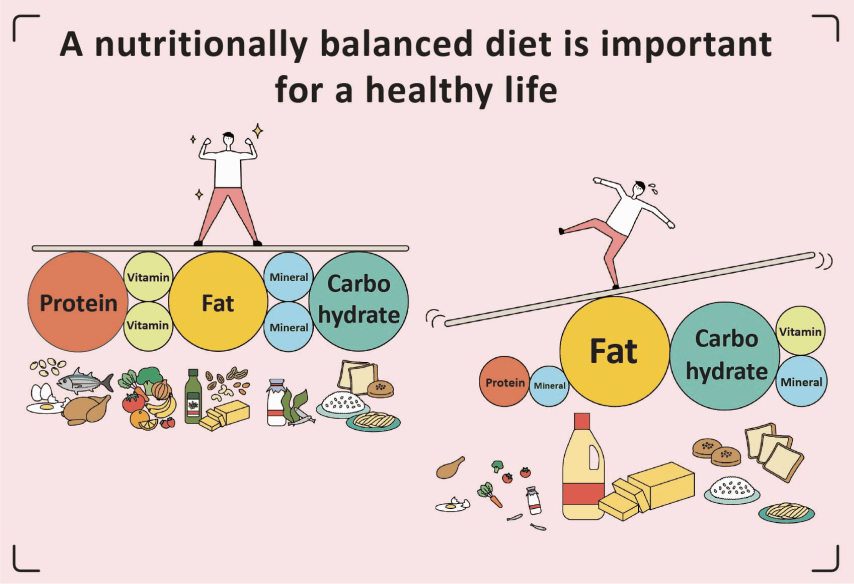
Similarly, reports on daily intake requirements of the nine essential amino acids have been jointly published by the Food and Agriculture Organization of the United Nations (FAO), the World Health Organization (WHO) and the United Nations University (UNU). These reports use “amino acid scores” as a way of assessing the nutritional value of dietary protein.
The amino acid score for a given food indicates the level of each essential amino acid contained in that food, as a ratio (%), in relation to a reference value. Chicken, for example, has an amino acid score of 100, indicating that it is high-quality protein containing an adequate proportion of each of the nine essential amino acids. By contrast, polished white rice has an amino acid score of 65, indicating that it is deficient in certain essential amino acids.
In a protein with an amino acid score of less than 100, the essential amino acid present in the lowest quantity is called the “limiting amino acid.” The nutritional value of a protein can be improved by supplementing the limiting amino acid.
Foods rich in essential amino acids
Major foods with an amino acid score of 100 (full score) that are rich in essential amino acids are listed below.
Chicken meat
Beef meat
Pork meat
Fish
Dairy products
Egg white
Therefore, essential amino acids are abundant in foods such as meat, seafood, eggs, and milk. By regularly including these foods in your diet, you can efficiently obtain essential amino acids.
Using the barrel theory to understand the balance of amino acids in proteins
To maintain good health, it is important to consume a diet that includes a proper balance of high-quality proteins containing sufficient amounts of essential amino acids, which the body cannot synthesize on its own. When essential amino acids are ingested in the right proportions, the body can utilize them effectively, minimizing waste. For each of the nine essential amino acids, there is a recommended daily intake.”
Essential amino acid requirements
| Essential amino acids | 0.5 years old | 1 to 2 years old | 3 to 10 years old | 11 to 14 years old | 15 to 18 years old | 18+ years old |
|---|---|---|---|---|---|---|
| mg/kg/day | ||||||
| Histidine | 22 | 15 | 12 | 12 | 11 | 10 |
| Isoleucine | 36 | 27 | 23 | 22 | 21 | 20 |
| Leucine | 73 | 54 | 44 | 44 | 42 | 39 |
| Lysine | 64 | 45 | 35 | 35 | 33 | 30 |
| Methionine+Cystine | 31 | 22 | 18 | 17 | 16 | 15 |
| Phenylalanine+Tyrosine | 59 | 40 | 30 | 30 | 28 | 25 |
| Threonine | 34 | 23 | 18 | 18 | 17 | 15 |
| Tryptophan | 9.5 | 6.4 | 4.8 | 4.8 | 4.5 | 4 |
| Valine | 49 | 36 | 29 | 29 | 28 | 26 |
| Essential amino acids Total |
377.5 | 268.4 | 213.8 | 211.8 | 200.5 | 184 |
The balance of essential amino acids found in foods can be illustrated using the image of a wooden barrel used to hold water. Each stave of the barrel represents a specific essential amino acid. For a food with an ideal balance of amino acids, such as egg, all the staves of the barrel are the same height, aligning neatly, so the barrel can be filled to the top, indicating that all nine essential amino acids can be utilized fully. In the case of wheat, however, some of the staves are shorter than others, so the barrel can only be filled as high as the shortest stave (corresponding to the limiting amino acid). This represents how a deficiency in one amino acid also limits the available amounts of the other amino acids. Similarly, if even one essential amino acid is missing, the barrel will not hold any water at all, indicating that the other amino acids are now unavailable, so they cannot be utilized and will simply be excreted as waste.
So, in the case of wheat, let’s consider what happens when the limiting amino acid, lysine, is supplemented. The lysine stave gets taller, allowing the barrel to hold more water, indicating that the other amino acids are also now available in higher amounts, and can be utilized more effectively.
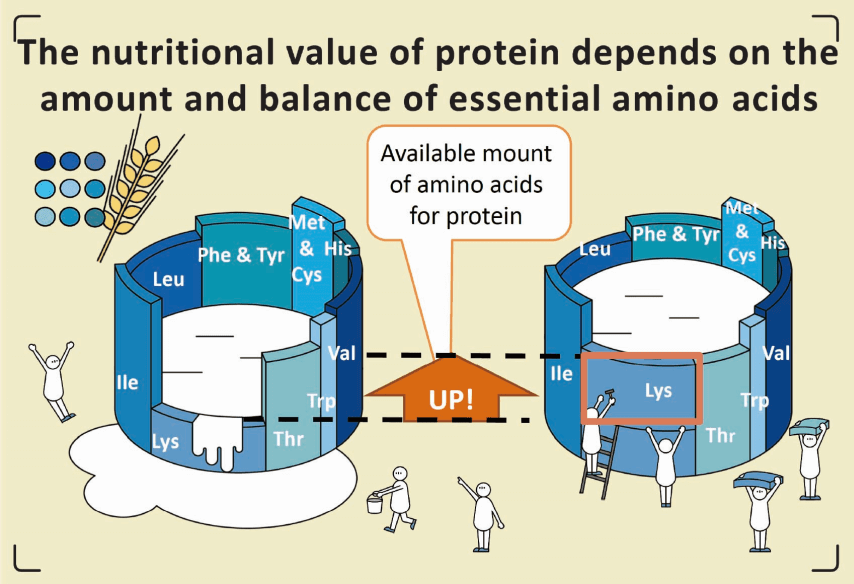
This “barrel theory” has been used to achieve nutritional improvement in many countries with poor diets, contributing to solutions to solve social problems.
The Ajinomoto Group's efforts to tackle the nutritional deficiencies in Africa
Many countries in Africa have been suffering from poor development of infants due to nutritional deficiencies, resulting in high fatality rates.
In Ghana, a traditional millet porridge called “koko” is widely eaten as a complementary food, and is often given to infants and young children. However, koko’s amino acid score shows that it does not meet the WHO’s nutrient requirements and dietary recommendations.
To address this nutritional gap, the Ajinomoto Group, in collaboration with various partners, developed KOKO Plus®1, a supplement containing amino acids and soybean protein, designed to improve nutrition in infants and young children. When added to koko during cooking, KOKO Plus® provides a good balance of essential amino acids along with calcium, iron, zinc, iodine, folic acid, vitamins A, B1, B2, B6, K1, D3, B12, and niacin. In 2018, the World Food Programme (WFP) verified the efficacy of KOKO Plus® and registered it as a “nutritious powder” in its food basket.
1 In 2017, the Ajinomoto Group transferred its official partnership role in the Ghana Nutrition Improvement Project to the Ajinomoto Foundation.
High-lysine foods, often featured in our daily diet, include dairy products, eggs, meat, fish, and soybeans. Rice, however, is low in lysine. It is therefore helpful to eat rice in combination with soybean products such as miso and tofu to ensure that we ingest the full complement of essential amino acids. To stay healthy, it is very important to eat a balanced diet covering all the essential amino acids.
The Ajinomoto Group supports the healthy lives of people all around the world by unlocking the power of amino acids. Read more about our approach to nutrition here.
Learn more about the Ajinomoto Group
Get to know us

Amino acids can be a beautiful barrier that builds confidence
Besides playing an important role in the skin’s own natural moisturizing factor, amino acids are also present in the stratum corneum, the protective barrier that forms the outermost layer of the skin. Collagen, a natural protein found in the dermis, giving the skin its firmness and elasticity, is also composed of amino acids.You may also like

Unlocking amino acids’ potential: passion and a bit of luck
This article explains the link between eating and amino acids and explains how amino acids can help solve the world’s health and nutritional challenges.